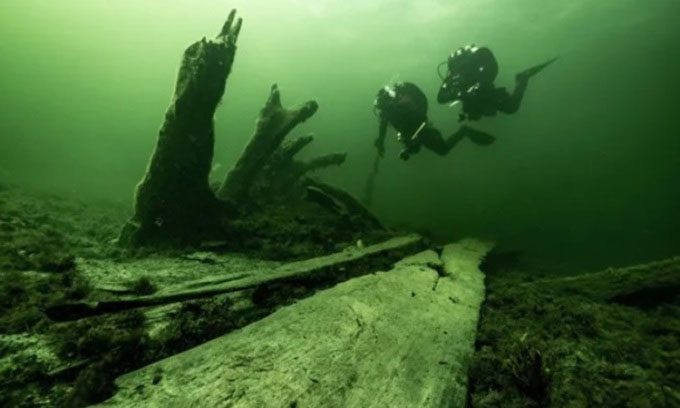A centuries-old weapon chest may help archaeologists understand the fire and explosion that sank the flagship of the Danish king.
Underwater archaeologists in Sweden have identified a chest on the wreck of a 15th-century warship containing tools for casting lead bullets for early firearms, Live Science reported on April 23. This discovery sheds light on key changes in naval warfare during that time. The wreck, named Gribshunden (Griffin Hound), is likened to a “floating castle” of the Danish royal family and sank in 1495 in a mooring area south of Sweden after a fire contributed to an explosion of gunpowder.

Archaeologist Johan Rönnby (left) and Rolf Warming swimming near the wreck of Gribshunden. (Photo: Florian Huber).
This discovery may clarify the fate of the ship, according to Rolf Warming, a maritime archaeologist and doctoral researcher at Stockholm University. Warming is a co-author of a new paper on the weapon chest and several other findings from the Gribshunden wreck, alongside Johan Rönnby, a maritime archaeologist and professor at Södertörn University in Sweden. The wreck was discovered by recreational divers in the 1970s, and Rönnby has been studying it since 2013.
The new findings also illustrate the early development of naval warfare from direct ramming and hand-to-hand combat in ancient times to attacking enemies from a distance using gunpowder, according to Warming. However, he emphasizes that this development took over a century to spread. “This marks the beginning of what we call maritime military evolution. Those tactics and technologies were only perfected in the latter half of the 17th century,” Warming stated.
Warming and Rönnby utilized photogrammetry, a technique that involves stitching together digital photographs to create an accurate 3D model of the weapon chest. The chest remains underwater at the wreck site in the coastal archipelago near the town of Ronneby, Sweden, but Warming hopes to recover it soon. Preserving the objects within the chest will be a lengthy process. Based on what can be seen from the upper layer of the chest, it contains several molds of different sizes for casting round lead bullets used in early firearms, lead plates for melting, and a cylindrical box that appears to be a cartridge case for a gun.
The research team identified the chest as an “zeuglade”, a type of toolbox used for creating ammunition. They speculate that the chest belonged to a German-speaking mercenary company aboard the ship when it sank. Additionally, a chainmail vest made of bronze from Nuremberg in Bavaria, dating back to the early 1400s, was also found on the wreck.
Gribshunden was the flagship of King Hans of Denmark, who was returning from the town of Kalmar in Sweden when the ship sank. King Hans and his entourage were not on board at that time. Kalmar was the site of discussions for an agreement to unify Denmark, Norway, and Sweden under one monarchy, known as the Kalmar Union. However, the agreement was suspended, and in 1945, King Hans sought to persuade Sweden to rejoin the union under his reign. Investigating the fire that sank the Gribshunden could help address lingering questions, such as whether the accident was an act of sabotage.


















































